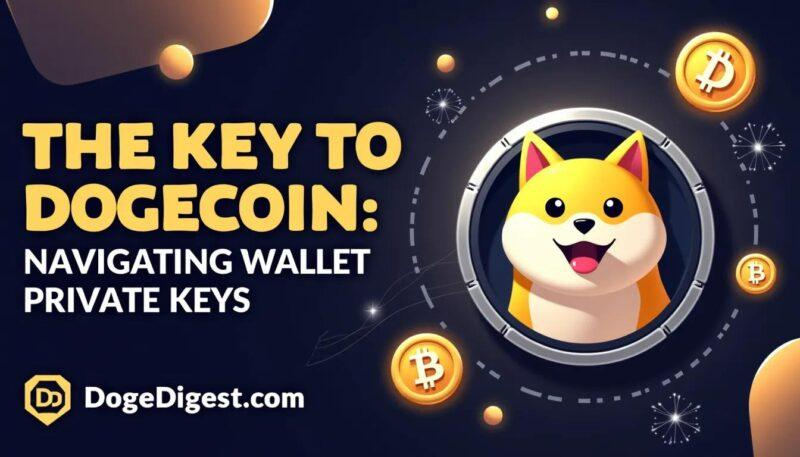In the rapidly evolving world of cryptocurrency, Dogecoin has emerged from a playful internet meme to a serious digital asset with a dedicated community. As more enthusiasts join the Dogecoin wave, ensuring the security of your holdings becomes paramount. Whether you’re a seasoned investor or just starting your crypto journey, safeguarding your Dogecoin means protecting not only your assets but also your peace of mind. This article delves into practical and effective security tips to help you keep your Dogecoin safe in an ever-changing digital landscape.
Choosing the Right Wallet for Maximum Dogecoin Protection
When it comes to protecting your Dogecoin, selecting the ideal wallet is paramount. Wallets come in various forms-each offering different levels of security, convenience, and accessibility. For those prioritizing top-notch safety, hardware wallets such as Ledger or Trezor stand out by storing private keys offline, making them virtually immune to hacking attempts. Meanwhile, software wallets offer easier access but require additional safeguards like strong passwords and two-factor authentication to mitigate risks.
Consider these critical factors when choosing your Dogecoin wallet:
- Control over private keys: The wallet must allow full control, ensuring that only you manage your funds.
- Backup and recovery options: A reliable backup system helps prevent total loss if your device is damaged or stolen.
- Compatibility: Confirm the wallet supports Dogecoin’s protocol and integrates seamlessly with your devices.
- Active development and community support: Trust wallets maintained with regular security updates and strong user communities.
| Wallet Type | Security Level | Convenience | Best For |
|---|---|---|---|
| Hardware Wallets | Very High | Moderate | Long-term holding |
| Desktop Wallets | High | High | Active traders |
| Mobile Wallets | Medium | Very High | Everyday spending |
| Paper Wallets | High | Low | Cold storage |
Implementing Multi-Factor Authentication to Secure Your Account
Adding an extra layer of defense beyond just a password is essential when protecting your Dogecoin wallet. By employing a security method that requires two or more forms of verification, you significantly reduce the risk of unauthorized access. This additional step typically involves something you know (like a password), something you have (a mobile device or hardware token), or something you are (biometric verification). Enabling this security feature transforms your login process into a robust checkpoint that most cyber attackers find difficult to bypass.
Setting up this advanced verification often involves apps such as Google Authenticator or Authy, which generate time-sensitive codes. After inputting your password, you’ll be prompted to enter a code from one of these apps, confirming your identity. Some exchanges and wallets also support hardware keys or biometric options for a seamless yet fortified login process. Integrating this simple habit into your digital routine ensures that even if your password is compromised, your Dogecoin remains secure.
Consider the following key benefits of enabling this security measure:
- Stronger defense against phishing attacks: prevents unauthorized login even if credentials are stolen.
- Reduced risk from password reuse: adds protection if the same password is compromised elsewhere.
- Real-time alerts: many implementations notify you of login attempts, keeping you informed.
| Authentication Method | Description | Ease of Use |
|---|---|---|
| Authenticator Apps | Generates time-based one-time codes. | Easy |
| SMS Codes | Text messages with verification codes. | Moderate |
| Hardware Tokens | Physical USB or NFC keys for authentication. | Advanced |
| Biometric | Fingerprint or facial recognition. | Very Easy |
Recognizing and Avoiding Common Dogecoin Scams
Crypto enthusiasts often encounter fraudulent schemes disguised as legitimate Dogecoin opportunities. Be wary of pump-and-dump schemes promising exponential returns overnight. These scams rely on manipulating prices through hype, only to leave victims holding worthless tokens when the market crashes. Always verify the credibility of any offer before investing, especially if it sounds too good to be true.
Phishing attempts are another common trap targeting Dogecoin holders. Scammers craft convincing emails, websites, or social media messages that imitate official platforms, urging you to reveal private keys or login credentials. A simple rule: never share your seed phrases or passwords. Use bookmarks for wallet sites and double-check URLs to avoid falling into this dangerous snare.
- Fake giveaways: Beware of offers claiming to multiply your holdings when you send Dogecoin first.
- Impersonated influencers: Accounts posing as well-known crypto personalities promising insider tips.
- Malicious apps: Unauthorized wallet or trading apps designed to steal funds.
| Scam Type | Warning Signs | How to Protect |
|---|---|---|
| Pump & Dump | Hyped price spikes | Research before investing |
| Phishing | Suspicious links & emails | Confirm URLs & use 2FA |
| Fake Giveaways | Requests to pre-send coins | Ignore unsolicited offers |
Best Practices for Safe Trading and Storage
Keeping your Dogecoin secure begins with understanding the environment in which you trade. Always use reputable and regulated exchanges that provide two-factor authentication (2FA) and regular security audits. Avoid trading from public Wi-Fi networks or unsecured devices, as these increase vulnerability to hacking attempts and phishing scams.
When it comes to storage, selecting the right wallet can make all the difference. Hardware wallets are the gold standard for long-term holding thanks to their offline security measures, while software wallets offer convenience for daily transactions but require extra caution. Remember to keep backup phrases and private keys stored safely offline – ideally in a fireproof safe or encrypted physical storage.
Implement these essential habits to bolster your Dogecoin security:
- Regularly update wallet software and exchange apps to patch vulnerabilities.
- Use multi-signature wallets to require multiple approvals for transfers.
- Beware of phishing links and always verify URLs before logging in.
- Monitor account activity and set up alerts for suspicious transactions.
| Security Measure | Key Benefit |
|---|---|
| Two-Factor Authentication (2FA) | Extra login layer to prevent unauthorized access |
| Hardware Wallets | Offline storage eliminates remote hacking risks |
| Regular Backups | Recover funds if device is lost or stolen |
| Phishing Awareness | Protects against fake sites and scams |
Staying Updated on Dogecoin Security Developments and Threats
In the rapidly evolving world of cryptocurrency, staying informed about the latest security updates and potential threats is your first line of defense. Monitoring official Dogecoin channels, such as their GitHub repository and verified social media accounts, ensures you catch critical announcements about vulnerabilities or network upgrades. Subscribing to specialized security newsletters and forums can further help you stay ahead, turning complex technical bulletins into actionable insights.
Regularly checking for software updates is crucial, but knowing which updates matter most requires discernment. Focus on releases marked as security patches or those addressing consensus mechanisms. Many vulnerabilities are exploited through outdated wallets or malicious third-party applications posing as trustworthy. To avoid this pitfall, always download software from official sources and verify digital signatures when available.
Key Practices to Maintain Vigilance:
- Enable alerts from reputable crypto security platforms
- Participate in community discussions on platforms like Reddit and Discord
- Keep an eye on emerging threat trends such as phishing tactics or 51% attack attempts
| Threat Type | Potential Impact | Proactive Measure |
|---|---|---|
| Phishing Attacks | Loss of private keys | Two-factor authentication (2FA) |
| Malicious Wallets | Fake transactions | Use trusted wallet software |
| Network Exploits | Double-spending risk | Update network nodes promptly |
Q&A
Q&A: Safeguarding Your Dogecoin – Top Security Tips
Q1: Why is securing my Dogecoin important?
A1: Just like cash in your wallet, your Dogecoin is valuable and vulnerable to theft. Cryptocurrencies operate on decentralized networks, which means once your coins are gone, they’re nearly impossible to recover. Proper security ensures your digital assets stay safe from hackers, scams, and accidental loss.
Q2: What’s the safest way to store my Dogecoin?
A2: Think of your Dogecoin wallet like a digital safe. Hardware wallets-physical devices that store your private keys offline-are considered the gold standard. They keep your keys away from internet threats, making unauthorized access much harder. Software wallets are convenient but riskier if your device is compromised.
Q3: How can I create a strong Dogecoin wallet password?
A3: Use a mix of uppercase and lowercase letters, numbers, and symbols to craft a password that’s both complex and memorable. Avoid common phrases or easily guessable info like birthdays. Consider using a reputable password manager to generate and store strong passwords securely.
Q4: Is it wise to share my Dogecoin wallet address publicly?
A4: Sharing your public wallet address is generally safe-it’s like giving someone a bank account number for deposits only. However, never share your private keys or seed phrases, as these grant full access to your Dogecoin. Keep those strictly confidential.
Q5: What are seed phrases, and why must I protect them?
A5: Seed phrases are a set of 12 to 24 words that act as a master key to your wallet. If you lose access to your wallet or device, the seed phrase lets you restore your funds. Store it offline, away from prying eyes-consider writing it down and keeping it in a secure location such as a safe.
Q6: Can using public Wi-Fi affect Dogecoin security?
A6: Absolutely. Public Wi-Fi networks are often unsecured, making it easier for hackers to intercept your data. Avoid accessing your Dogecoin wallet or conducting transactions on public Wi-Fi unless you use a trusted VPN to encrypt your connection.
Q7: How do I spot and avoid Dogecoin scams?
A7: Be skeptical of offers that sound too good to be true-like promises of doubling your coins or free giveaways. Never send Dogecoin to unknown parties without verifying their credibility. Official websites and community forums are your best bet for reliable information.
Q8: Should I enable two-factor authentication (2FA) for my Dogecoin accounts?
A8: Yes! 2FA adds an extra layer of security by requiring a second verification step-usually via a smartphone app or text message. Even if someone gets your password, they’ll need that second factor to access your account, significantly reducing hacking risks.
Q9: How often should I update my wallet software?
A9: Regular updates are crucial. They patch security vulnerabilities and improve functionality. Check for updates frequently and install them promptly to keep your wallet defense strong against emerging threats.
Q10: What’s the best mindset to maintain when handling Dogecoin security?
A10: Treat your Dogecoin like any valuable treasure-with vigilance, caution, and respect. Staying informed, following best practices, and never cutting corners will help you enjoy peace of mind in the exciting world of cryptocurrency.
Closing Remarks
In the ever-evolving world of cryptocurrency, protecting your Dogecoin is more than just a precaution-it’s a necessity. By adopting smart security practices and staying vigilant, you can safeguard your digital assets against the unpredictable risks of the cyber landscape. Remember, the strength of your Dogecoin’s security lies not just in technology, but in the mindful habits you cultivate. Stay informed, stay cautious, and let your Dogecoin journey be as secure as it is exciting.






